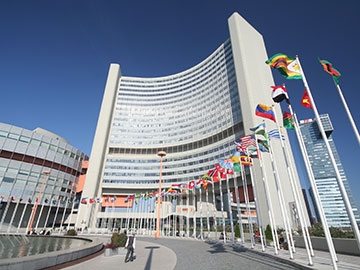IAEA’s headquarters in Vienna:

The International Atomic Energy Agency has just announced a competition to develop “innovative ways to visualize, analyze and explore” simulations of different materials that could be use to construct nuclear fusion reactors. Any such material would have to be able to withstand extremely high temperatures and energetic particles.
The IAEA hopes that the responses to the new challenge will help with the construction of a demonstration nuclear fusion power reactor. If such a reactor can be constructed, it will prove that the generation of net electrical power from a fusion reactor is economically feasible. This would be the final step before the actual construction of commercial nuclear fusion power plants.
The IAEA said that "Harnessing commercially-viable fusion power involves serious technological challenges that are expected to take many years to solve, including protecting the wall and other components of the reactor vessel from extremely high temperatures and energetic particles," the agency said. Tungsten, steel and beryllium are candidates for use in the containment vessel for a fusion reactor.”
“Since experiments on physical samples are difficult and expensive to carry out, scientists have turned to computational models to simulate the behavior of a material. Different metals or compositions, impact energies and temperatures can be explored [using molecular dynamics] and can help with the search for an effective first wall material.”
Christian Hill is the head of the IAEA’s atomic and molecular data unit. He pointed out that very high temperatures are one of the major requirements for the construction of a fusion reactor. He said, "At such high temperatures - ten times higher than is found at the core of our Sun - matter exists only as plasma, which must be confined by a magnetic field to keep it from damaging the reactor walls.”
The IAEA is hoping to attract “experts and self-taught enthusiasts” to study simulations of the damage that can be sustained by the wall of a fusion reactor vessel under bombardment by energetic neutrons generated by the fusion reaction. Some of the factors that the IAEA says will have to be taken into consideration in the submissions of the participants include:
• The use of new and innovative software for visualizing the damage data in a way that “aids qualitative and quantative assessment.”
• The use of new and innovative software to quickly “identify, classify and quantify new patterns and structures of particular kinds in the data set.”
• The development of more efficient algorithms to visualize and “summarize the statistical distribution of atomic displacement and to analyze the effect of impact energy on this distribution.”
Hill also said that "By participating in this challenge, both specialists and non-specialists will be helping scientists to better understand how a material responds to high-energy events and will assist the development of a future fusion reactor." The deadline for submissions is July 14, 2018. The winner will be announced on August 15, 2018. They will receive about six thousand dollars and will be invited to the IAEA’s headquarters in Vienna to present their findings.